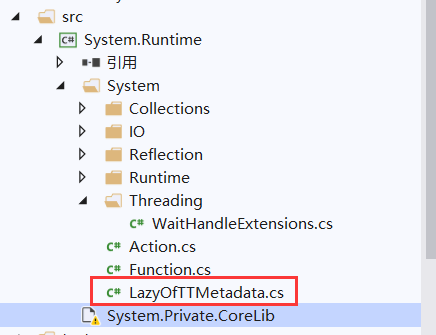Core源码(三) Lazy<T>
Lazy<T>解决什么问题?
1、大对象加载
考虑下面的需求,有个对象很大,创建耗时,并且要在托管堆上分配一大块空间。我们当然希望,用到它的时候再去创建。也就是延迟加载,等到真正需要它的时候,才去加载。
显然,这里需要加一个中间层,将大对象封装起来,暴露接口,开始并不创建大对象,等到用户真正访问对象的时候,再去创建。另外,这个中间层应该可以封装不同类型的大对象,因此需要类模版。Lazy<T>就是为了解决这个问题。
典型的使用
public Lazy<AccountService> AccountServ = new Lazy<AccountService>();
public Lazy<ProductService> ProductService = new Lazy<ProductService>();
2、将委托或者方法对象保存,并在需要的时候调用。
private readonly Lazy<IDbConnection> _connectionLazy;
public CallHistoryRepository(ConnectionFactory connectionFactory)
{
_connectionLazy = new Lazy<IDbConnection>(()=>connectionFactory.Connection);
}
一旦使用.Vale,那么对应的变量就会被实例化,IsValueCreated属性也就变成了true。
实现自己的Lazy<T>
在.NET Framework 4.0之前,大对象就是存在的,那么对于一个大型系统而言,怎么样对付一个大对象呢。主要有两点:延迟加载和即时清理。前者解决创建问题,后者解决回收问题。
那么在来看Lazy<T>的.NET Framework实现之前,我们先来自己实现一个简单的Lazy<T>吧。
class MyLazy<T> where T : new()
{
private T value;
private bool isLoaded;
public MyLazy()
{
isLoaded = false;
}
public T Value
{
get
{
if (!isLoaded)
{
value = new T();
isLoaded = true;
}
return value;
}
}
}
这应该是最简单版本的Lazy<T>了,没有线程安全检测,只有着访问时创建真实对象,可是对于我们一般的应用来说也许就已经足够了。
.NET Lazy<T> 实现
.NET Core和我们的实现,有两点主要的不同:
1、 引入了Boxed内部类:
[Serializable]
private class Boxed
{
// Fields
internal T m_value; // Methods
[TargetedPatchingOptOut("Performance critical to inline this type of method across NGen image boundaries")]
internal Boxed(T value)
{
this.m_value = value;
}
}
该内部类取代了我在上面实现中的泛型约束,使之更通用。
但是我们也应该注意到,如果T为结构体,那么由于T很大,所以装箱拆箱反而也许是个更耗费效率的事情,因此,个人建议,对值类型慎用Lazy<T>。
2、 线程安全的控制
在线程安全的控制选项中,.NET Framework为我们提供了这样的枚举选项:
public enum LazyThreadSafetyMode
{
None,
PublicationOnly,
ExecutionAndPublication
}
默认值为ExecutionAndPublication
枚举选项MSDN介绍如下
http://msdn.microsoft.com/en-us/library/system.threading.lazythreadsafetymode%28VS.100%29.aspx
isThreadSafe则应用于多线程环境下,如果isThreadSafe为false,那么延迟加载对象则一次只能创建于一个线程。
Lazy<T>源码
System.Runtime命名空间下
由于core中的lazy源码我只找到了下图这个,再往下lazy的实现并没找

所以我使用.Net 4.5的lazy源码

一、最常使用的属性Value
[DebuggerBrowsable(DebuggerBrowsableState.Never)]
public T Value
{
get
{
Boxed boxed = null;
if (m_boxed != null )
{
// Do a quick check up front for the fast path.
boxed = m_boxed as Boxed;
if (boxed != null)
{
return boxed.m_value;
}
LazyInternalExceptionHolder exc = m_boxed as LazyInternalExceptionHolder;
Contract.Assert(m_boxed != null);
exc.m_edi.Throw();
}
return LazyInitValue();
}
}
//null --> value is not created
//m_value is Boxed --> the value is created, and m_value holds the value
//m_value is LazyExceptionHolder --> it holds an exception
private object m_boxed;
如果m_boxed有值,就直接装箱返回对应值(这里就要注意值类型装箱的性能损失了)。这个装箱是为了检验下m_boxed的值,因为其中有可能是异常。
二、LazyInitValue方法
如果m_boxed为空,就调用LazyInitValue方法,这里有针对线程安全模式的判断
/// <summary>
/// local helper method to initialize the value
/// </summary>
/// <returns>The inititialized T value</returns>
private T LazyInitValue()
{
Boxed boxed = null;
LazyThreadSafetyMode mode = Mode;
if (mode == LazyThreadSafetyMode.None)
{
boxed = CreateValue();
m_boxed = boxed;
}
else if (mode == LazyThreadSafetyMode.PublicationOnly)
{
boxed = CreateValue();
if (boxed == null ||
Interlocked.CompareExchange(ref m_boxed, boxed, null) != null)
{
// If CreateValue returns null, it means another thread successfully invoked the value factory
// and stored the result, so we should just take what was stored. If CreateValue returns non-null
// but we lose the ---- to store the single value, again we should just take what was stored.
boxed = (Boxed)m_boxed;
}
else
{
// We successfully created and stored the value. At this point, the value factory delegate is
// no longer needed, and we don't want to hold onto its resources.
m_valueFactory = ALREADY_INVOKED_SENTINEL;
}
}
else
{
object threadSafeObj = Volatile.Read(ref m_threadSafeObj);
bool lockTaken = false;
try
{
if (threadSafeObj != (object)ALREADY_INVOKED_SENTINEL)
Monitor.Enter(threadSafeObj, ref lockTaken);
else
Contract.Assert(m_boxed != null); if (m_boxed == null)
{
boxed = CreateValue();
m_boxed = boxed;
Volatile.Write(ref m_threadSafeObj, ALREADY_INVOKED_SENTINEL);
}
else // got the lock but the value is not null anymore, check if it is created by another thread or faulted and throw if so
{
boxed = m_boxed as Boxed;
if (boxed == null) // it is not Boxed, so it is a LazyInternalExceptionHolder
{
LazyInternalExceptionHolder exHolder = m_boxed as LazyInternalExceptionHolder;
Contract.Assert(exHolder != null);
exHolder.m_edi.Throw();
}
}
}
finally
{
if (lockTaken)
Monitor.Exit(threadSafeObj);
}
}
Contract.Assert(boxed != null);
return boxed.m_value;
}
三、CreateValue方法
返回一个实例对象T,采用传入的func方法,这里会对是否已经返回做出判断,如果已经返回,就返回null
/// <summary>Creates an instance of T using m_valueFactory in case its not null or use reflection to create a new T()</summary>
/// <returns>An instance of Boxed.</returns>
private Boxed CreateValue()
{
Boxed boxed = null;
LazyThreadSafetyMode mode = Mode;
if (m_valueFactory != null)
{
try
{
// check for recursion
if (mode != LazyThreadSafetyMode.PublicationOnly && m_valueFactory == ALREADY_INVOKED_SENTINEL)
throw new InvalidOperationException(Environment.GetResourceString("Lazy_Value_RecursiveCallsToValue"));
Func<T> factory = m_valueFactory;
if (mode != LazyThreadSafetyMode.PublicationOnly) // only detect recursion on None and ExecutionAndPublication modes
{
m_valueFactory = ALREADY_INVOKED_SENTINEL;
}
else if (factory == ALREADY_INVOKED_SENTINEL)
{
// Another thread ----d with us and beat us to successfully invoke the factory.
return null;
}
boxed = new Boxed(factory());
}
catch (Exception ex)
{
if (mode != LazyThreadSafetyMode.PublicationOnly) // don't cache the exception for PublicationOnly mode
m_boxed = new LazyInternalExceptionHolder(ex);
throw;
}
}
else
{
try
{
boxed = new Boxed((T)Activator.CreateInstance(typeof(T))); }
catch (System.MissingMethodException)
{
Exception ex = new System.MissingMemberException(Environment.GetResourceString("Lazy_CreateValue_NoParameterlessCtorForT"));
if (mode != LazyThreadSafetyMode.PublicationOnly) // don't cache the exception for PublicationOnly mode
m_boxed = new LazyInternalExceptionHolder(ex);
throw ex;
}
}
return boxed;
}
最新文章
- Android源码——Broadcast Receiver
- NOI2018准备Day13晚
- 继续(3n+1)猜想
- NOIP2003pj数字游戏[环形DP]
- Apache POI使用详解
- Centos修改镜像为国内的163源
- The Economist
- Zend Studio 12.0.2正式版发布和破解方法,zend studio 12.0.1汉化,相式设置为Dreamweaver,空格缩进为4个, 代码默认不折叠的设置,Outline中使用的图形标志,代码颜色之eot设置。
- PHP第一课笔记
- poj1159 Palindrome
- (转)request.getSession()几种获取情况之间的差异
- [转] 关于QT的系统总结
- Nginx TCP Proxy模块的编译安装
- Perl 学习笔记-高级控制结构
- 用C语言指针作为函数返回值
- 安装wamp后,其显示目录的图标显示不出来
- 树莓派研究笔记(7)-- lakka 《仙剑奇侠传》的完美移植
- 在写fegin客户端的时候无法继承接口
- codeforce Gym 100570B ShortestPath Query (最短路SPFA)
- wifi方式调试android程序
热门文章
- java之方法的重载(overload)
- IT兄弟连 HTML5教程 CSS3揭秘 CSS规则的组成
- jQuery 源码解析(二十六) 样式操作模块 样式详解
- SPARQL入门(一)SPARQL简介与简单使用
- 微软、IBM、GitLab 等大厂全部到齐的 OCS 第一天有什么看点?
- Kafka基本知识整理
- (十六)c#Winform自定义控件-文本框哪里去了?-HZHControls
- (转)颜色直方图, HSV直方图, histogram bins
- 浅谈浏览器解析 URL+DNS 域名解析+TCP 三次握手与四次挥手+浏览器渲染页面
- 201871010102-常龙龙《面向对象程序设计(java)》第十五周学习总结